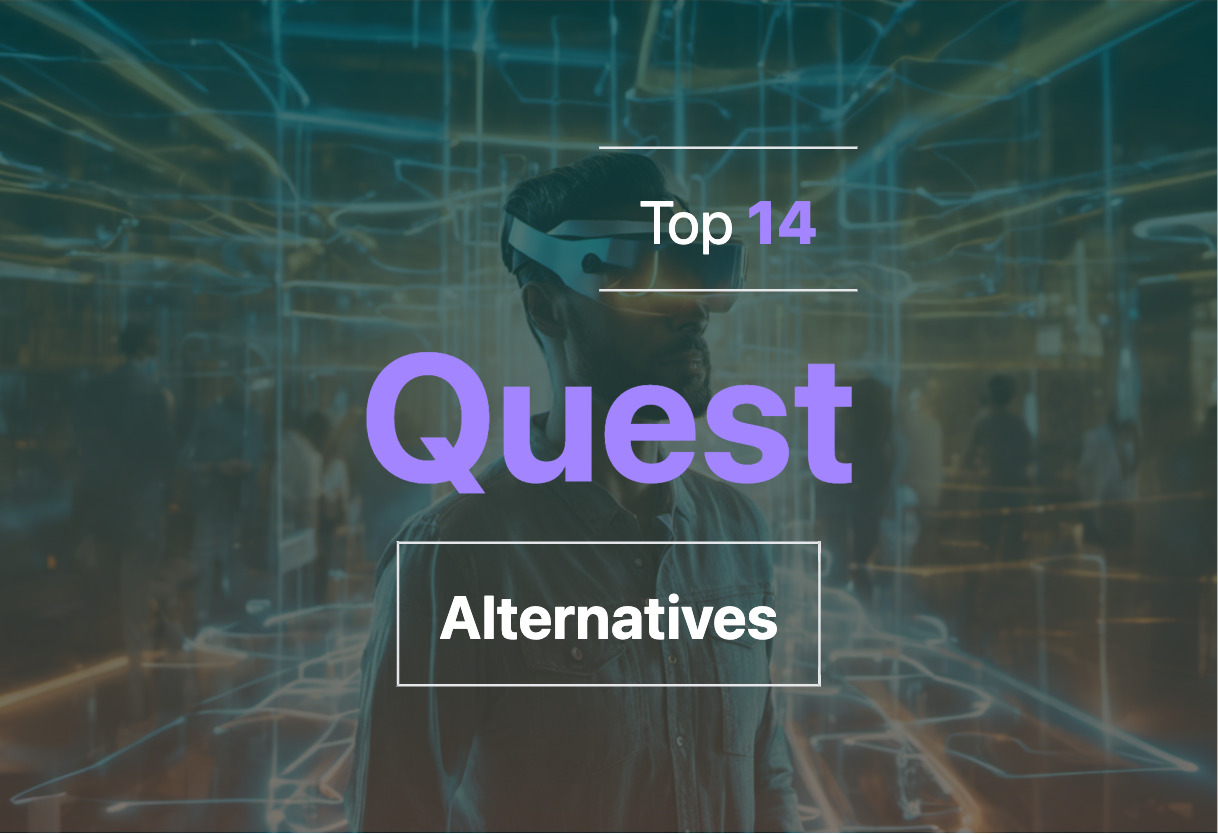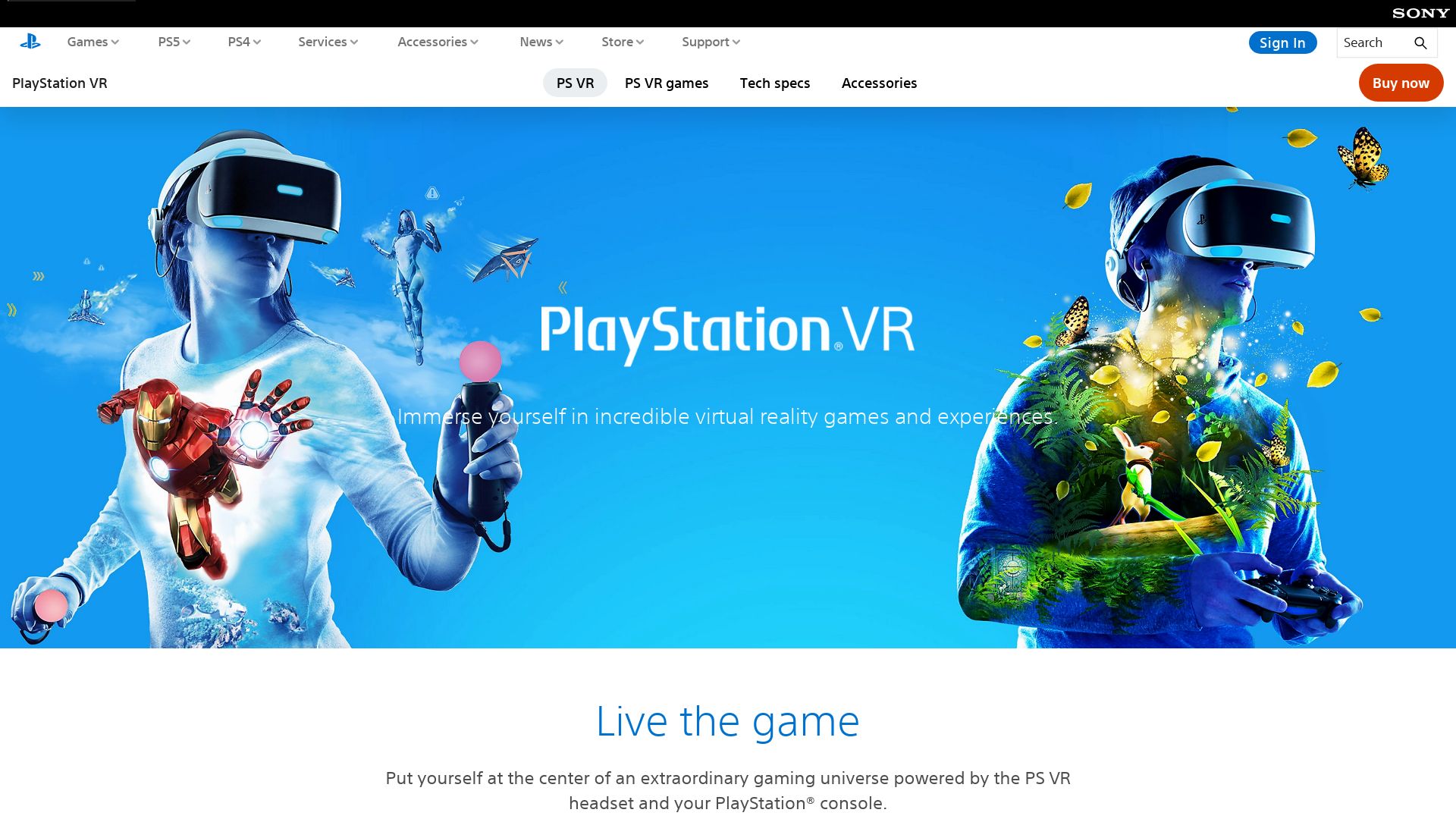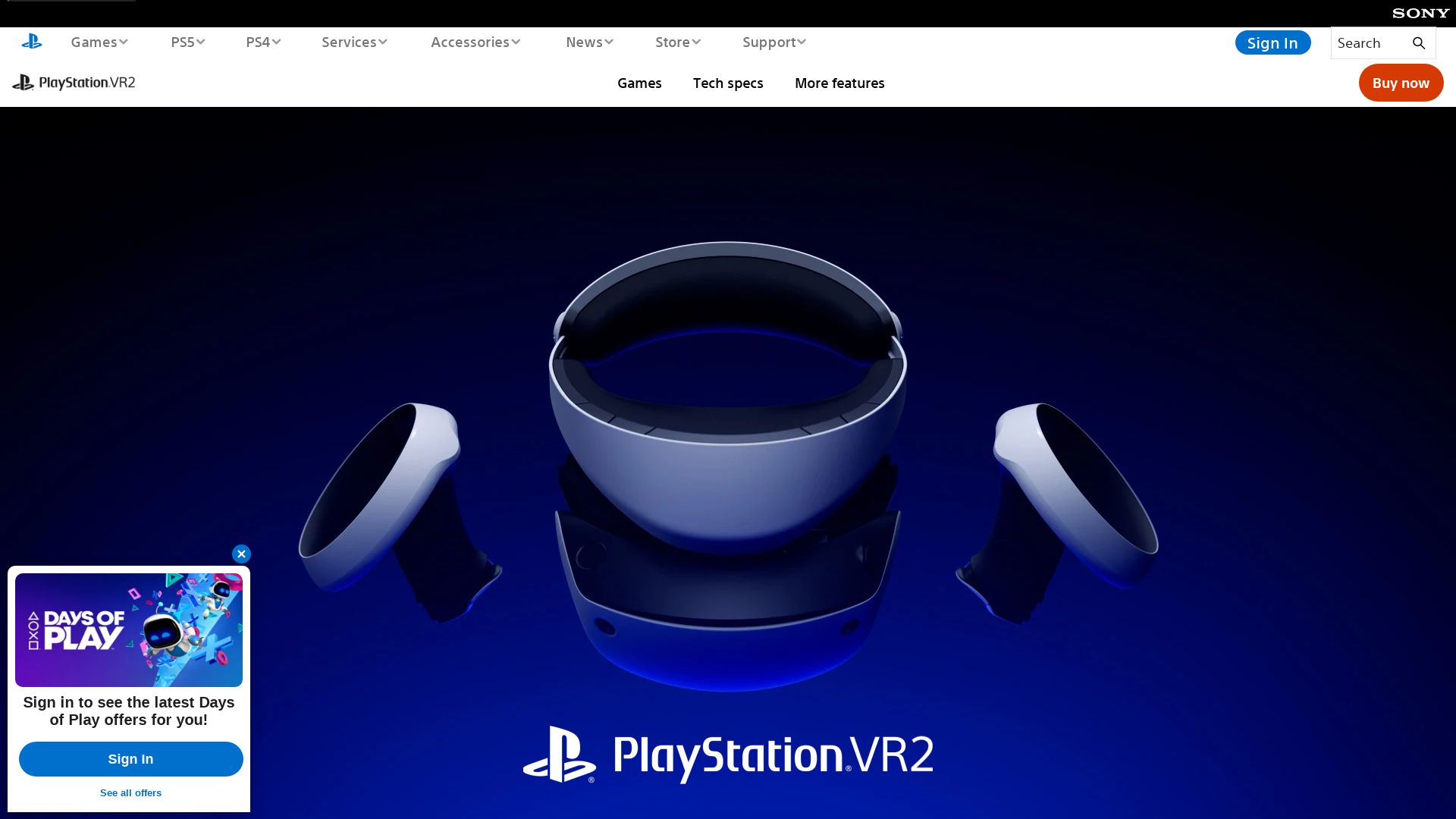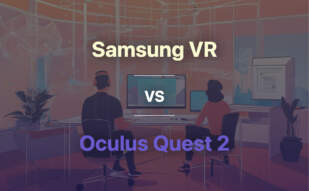Quest is a leading VR headset developed by Oculus under Facebook’s Meta brand. With features like dual hand controllers, standalone design, and support for popular gaming experiences, Quest has redefined the VR experience. The latest iteration, Quest 3 (Meta Quest 3), boasts enhanced graphics performance, innovative machine learning capabilities, and a next-gen Snapdragon chipset for unparalleled immersive experiences.

Looking for alternatives to Quest? Explore options like Three.js, WebGL, WebGL 2, WebVR, WebXR, OpenXR, React Three Fiber, p5.js, Pixi.js, Babylon.js, A-Frame, X3DOM, Deck.gl, and VTK.js.
Quest 2
The Quest 2, developed by Reality Labs under Meta Platforms, formerly known as Oculus Quest 2, is a high-performing VR headset with an advanced Android-based OS, offering either standalone or PC-dependent operations.
Best Features of Quest 2
- Processor: Qualcomm SnapDragon XR2
- Memory: 6 GB LPDDR4X
- Display: RGB LCD; 1832 x 1920 per eye, refresh rates 72-120 Hz
- Sound: 2 integrated speakers, 3.5mm headphone jack
- Input: 6DOF inside-out tracking via four inbuilt cameras and two controllers
| Internal Storage | Online services | Weight |
|---|---|---|
| 128 GB, 256 GB available | Quest Store | 503 g (17.7 oz.) |
Limitations of Quest 2
- Limited battery life: 2-3 hours between charges
- No room for storage expansion
Quest 2 Pricing
The Quest 2 is priced at $299 for the now-discontinued 64 GB version, and $399 for the 256 GB version.
Quest 2 Use Cases
Use case 1: VR Gaming
With dozens of VR games in its associated Quest Store, Quest 2 is a perfect choice for VR gamers seeking a high refresh rate and resolution experience.
Use case 2: VR Experiences
With high-end features such as 6DOF tracking and integrated speakers, the Quest 2 is ideal for immersive VR experiences.
Use case 3: VR Software Development
Thanks to its Android-based OS, the Quest 2 is an excellent device for VR software developers who need a high-performance standalone VR headset.
Quest
Your journey for the ultimate VR experience ends at Quest, the audacious product of Meta’s Oculus. Launched with a resolve to make VR mainstream, this standalone headset needs no wimpy tethering to a phone or PC. It boldly breaks the chains with its wireless design and proudly flaunts the glory of being Oculus’s fourth consumer VR headset.
Quest Top Features
- Standalone Design: Free yourself from the bound of wires and computers. Revel in the liberation.
- High Resolution: Witness the splendor of 1600 x 1440 pixels per eye. Immerse into unmatched visual experiences.
- Experience Rich: Access to over 500 VR games and experiences. It ain’t bragging if you back it up!
- Revolutionary Controllers: Equipped with redesigned Touch Plus controllers for unbeatably accurate tracking and optional Meta Quest Touch Pro Controllers for those who crave the ultra-premium.
- Superior Processor: Featuring Snapdragon 865-derived Snapdragon XR2, Quest ensures smoother and richer gaming experiences.
| Feature | Bonus |
|---|---|
| Adaptive Spaces | Remember up to five spaces and automates swapping between them for seamless adaptation. |
| PC Tethering | Optional accessory cable offers access to graphic-intensive VR wonders. |
| High-fidelity Passthrough | Experience next-level spatial understanding with leading-edge machine learning. |
Quest Limitations
- Relatively Short Battery Life: Lasts up to a maximum of three hours, which may be a limitation for marathon VR sessions.
- Aged Chipset: Uses a 2017 model Qualcomm Snapdragon 835 mobile chipset. Could feel a bit outdated for tech enthusiasts.
- Limited Storage Options: Choice of only 64GB or 128GB storage with a 256GB variant at an extra cost
Quest Pricing
Get your hands on the 128GB variant of Quest for $399. If the audacious crave for more, there’s a 256GB option available at an additional cost. And gear up for the forthcoming “Meta Quest 3” arriving in fall 2023 pricetagged at $499.99.
Quest Use Cases
Use Case 1 – Gaming
With 500+ compatible VR games, Quest offers the world’s best library of immersive experiences for gamers. Get your adrenaline pumpin’ with games like Beat Saber, The Climb, Robo Recall and many more.
Use Case 2 – Entertainment
For the devotees of VR entertainment, explore dozens of mesmerizing experiences. Revel in the high-fidelity color Passthrough. Dazzle yourself in vibrant Virtual Reality.
Use Case 3 – Education and Training
Enhance learning and training experiences. Take advantage of Quest’s innovative machine learning for spatial understanding.
HoloLens
A revolutionary step forward in mixed reality, Microsoft’s HoloLens is transforming myriad sectors, by providing enterprise-ready solutions that boost accuracy and productivity. As a bonafide self-contained and untethered holographic device, it has made noteworthy leaps since the release of its first version in 2015 with the current model HoloLens 2 holding a commanding ground in AR technology.
HoloLens Best Features
- Holograms: Creates intricate, interactive holograms for utmost immersion.
- Voice Control (Cortana): Facilitates hands-free operation through intelligent assistant Cortana.
- Microsoft Azure Integration: Easy integration with Microsoft’s robust cloud services, Azure.
- Biometric Recognition & Eye-tracking: Enhanced usability via biometric recognition and eye-tracking technologies.
- Spatial Audio: Immersive spatial audio technology for a complete sensory experience.
| Compatible software | Use |
| Trimble’s SketchUp Viewer | AR maintenance |
| Microsoft Teams | Secure live video feeds |
| Autodesk’s FreeForm | 3D design visualization |
HoloLens Limitations
- Pricewise, the HoloLens might be considered steep for some, especially on an individual or small business scale.
- Size, weight, and relatively limited field of view could potentially hamper user immersion and comfort.
- Dependency on the Windows ecosystem and applications could deter some users.
HoloLens Pricing
The HoloLens line comprises of a standard version priced at $3,500 and an Industrial Edition, designed for clean rooms and hazardous locations, priced at $4,950.
HoloLens Use Cases
Use case 1 – Healthcare
A testament to its usability in the healthcare sector, ApoQlar, a medical startup, utilizes HoloLens to explain complex surgical procedures to patients through hologram visualizations. Similarly, MEDIVIS incorporates HoloLens for comprehensive surgery planning.
Use case 2 – Manufacturing & Construction
In the manufacturing and construction sector, companies like Lockheed Martin deploy HoloLens to exact precision in constructing deep-space vehicles, while in a first for the automobile industry, Mercedes-Benz used it for remote assistance during the COVID-19 pandemic.
Use case 3 – Education
The HoloLens has shown considerable efficacy in scientific and medical education, allowing for comprehensive physiological, anatomical, and pathological visual representations, not to mention its application in fields like engineering software design tools, and remote maintenance.
Apple Vision Pro
Apple Vision Pro is a cutting-edge mixed reality headset that blends digital content into the physical world while elevating user engagement through advanced navigation features.
Apple Vision Pro Top Features
- Integrated use of voice, eyes, and hands for interactive navigation.
- An ‘infinite canvas’ for apps with adjustable size and arrangement.
- A premium entertainment hub transforming your room into a personal theater.
- 3D camera for capturing spatial photos and videos.
- Compact form factor leveraging Apple’s expertise in high-performance, mobile, and wearable devices.
- VisionOS, Apple’s first spatial OS, foundationally built on macOS, iOS, and iPadOS.
- Deploys advanced technology for immersive spatial experiences.
- Strong focus on user privacy via Optic ID, using unique iris patterns for authentication.
| Feature | Details |
|---|---|
| EyeSight | Displays user’s eyes for communication transparency and improved interaction |
| Dual-Chip Processor | Apple M2 and Apple R1 for unmatched 3D experiences |
| Spatial Audio System | Adapts audio to align with the user’s environment |
Apple Vision Pro Downsides
- Expensive price point, positioning it as a luxury device.
- External, wearable Battery with only 2-hour battery life, though the possibility of continuous use exists when plugged in.
- Availability remains in the future (2024), potentially limiting its immediate adoption.
Apple Vision Pro Pricing
Apple Vision Pro is scheduled to go on sale in early 2024, starting at $3,499.
Apple Vision Pro Use Cases
Use case 1: Enhanced Collaboration
With life-size FaceTime video tiles and simultaneous working on documents, it offers a new dimension to virtual meetings.
Use case 2: Immersive Entertainment
The device transforms any room into a personal theater, redefining the at-home cinema experience.
Use case 3: Intuitive Augmented Reality Development
Vision Pro Developer Kits open avenues for developers to test and build immersive 3D content, bridging the gap between the digital and physical worlds.
PSVR

Take a plunge into immersive gaming with PSVR (PlayStation VR), a revolutionary virtual reality headset introduced by Sony Interactive Entertainment. Born out of Project Morpheus, this eighth generation gaming phenomenon has been enthralling gamers across the globe since its first commercial launch in October 2016.
PSVR Top Features
- Beyond limitation experience with a 5.7-inch OLED panel that ensures a 1080p display resolution and 960 x 1080 pixels per eye.
- Offers three gameplay modes comprising native 90 Hz, native 120 Hz, and interpolated 120 Hz.
- Enhanced interactive capabilities through PlayStation Camera which allows for head tracking, LED tracking and essential VR functionality.
- Utilize Cinematic Mode for a thrilling non-VR games viewing on a simulated projection screen in 3D space.
- Compatible with 360-degree photos and videos, 3D movies on Blu-Ray 3D, Share Play and Live from PlayStation.
| Features | Usability |
|---|---|
| Controller options | Variety of options including regular PS4 controller, PlayStation Move controllers, PlayStation VR Aim controller |
| Connectivity | Can connect to TV, displaying user’s view or separate image for other players. |
| Weight | At 600 grams, ensures comfort during extended gaming sessions. |
PSVR Downsides
- Primary functionality restricts to gaming with PlayStation 4 console, though backward compatibility with PlayStation 5 is possible.
- Demands PlayStation Camera peripheral for head tracking, VR functionality and LED tracking.
- While it supports 360-degree photos, it’s primarily gaming-centric
PSVR Pricing
With a price tag of $399 in the US, affordability might be a concern for some though it is rightly countered by the thrilling experiences PSVR guarantees.
PSVR Use Cases
Audience: Hardcore Gamers
For those craving intense gaming sessions, PSVR’s impressive features enhance gaming experiences – witnessing breathtaking scenes, reacting in real-time, and feeling the adrenaline rush like never before.
Audience: VR Enthusiasts
The compatibility with both 2D and 3D content, coupled with its advanced hardware, makes PSVR a top pick for VR enthusiasts interested in exploring beyond the typical gaming scenario.
Audience: Tech-Savvy Casual Gamers
For casual gamers with an inclination towards the latest technology, the PSVR serves as a perfect tool. Its interactive features, immersive experience and user-friendly controllers significantly elevate casual gaming.
PSVR 2

Sony’s next-generation VR solution, the PSVR 2, brings a major upgrade over its predecessor with notable improvements and features tailored for immersive gaming on PlayStation 5.
PSVR 2 Top Features
- Upgraded from original PSVR’s 960 x 1,080-pixel displays to a crisp 2000 x 2040 resolution per eye with up to 120Hz refresh rate.
- Eyeball tracking system to provide more accurate and immersive gameplay.
- Vivid HDR support, enhancing display performance surpassing Meta Quest 2.
- Comes with robust Sense controllers, providing greater motion tracking and interactions.
- No need for external accessories; Directly plugs into PS5 with a single USB-C.
- Comfort-focused design with an adjustable lens module and sturdy headband.
| Item | Feature |
|---|---|
| Inside-out tracking | Eliminates need for external sensors or cameras |
| Sense Controllers | Enhanced with adaptive triggers and finger tracking |
| Seamless VR Experience | Dedicated passthrough button for hassle-free transitions |
PSVR 2 Downsides
- Batteries run out quickly impacting long play sessions.
- Limited library of compatible games and non-backward compatibility with PSVR 1.
- Despite its compelling features, the high price tag of $550 might prove prohibitive for some users.
- Incompatibility with PC platforms narrows user-base.
PSVR 2 Pricing
The PSVR 2 comes with a price tag of $549.99/£529.99. Additional costs may incur for accessories such as the Sense Controller Charging Dock and Pulse Headset.
PSVR 2 Use Cases
Use case 1
For hardcore console gamers, the PSVR 2 provides an enriching VR experience, taking advantage of the powerhouse performance of the PlayStation 5.
Use case 2
For tech enthusiasts seeking high-end VR hardware, PSVR 2 blends cutting-edge tech like eye-tracking and immersive haptic feedback for a superior immersive experience.
Use case 3
For streamers, the PSVR 2’s automatic streaming to TV functionality allows effortless showcase of VR gameplay to a live audience.
Quest 3
Acquaint yourself with the Quest 3, a cutting-edge mixed reality headset from Meta, tailored to take your virtual encounter to epoch-making levels.
Quest 3 Top Features
- The headset boasts a groundbreaking mixed reality that facilitates Immersive experiences.
- It’s powered by the Snapdragon XR2 Gen 2 platform, ensuring double the graphics processing power of its predecessor, the Quest 2.
- 30% leap in resolution, offering 4K+ Infinite Display
- Evolved sound clarity, bass performance, and 40% louder audio range compared to Quest 2.
- Comfort meets customization with a redesigned, thinner profile and soft adjustable strap design.
- Upgraded mixed reality capabilities including full-color passthrough and easier spatial mapping.
| Aspect | Benefit |
| New depth sensor, updated cameras | Allows for an automatic guardian system to prevent collisions, creating new “spatial data”. |
| Snapdragon XR2 Gen 2 platform | Delivers double the graphics processing power of Quest 2 and improved mixed reality capabilities. |
| Backward compatibility | Compatible with Quest 2 titles, opening up an array of gaming experiences. |
Quest 3 Disadvantages
- Costs more than its predecessor, potentially discouraging budget-conscious users.
- Robust computational requirements may require users to upgrade existing hardware.
Quest 3 Pricing
Two versions are available: a 128GB model at $499.99 and a 512GB model at $649.99.
Quest 3 Use Cases
Use case 1: Augmented Reality Gaming
With its advanced graphics and immersive mixed reality features, Quest 3 takes gaming to new dimensions. The instance of Demeo showcases Quest 3’s superior gaming prowess.
Use case 2: Interactive Fitness Training
Quest 3’s features such as Xponential+ supports fitness enthusiasts for immersive workout sessions.
Use case 3: Local Multiplayer
The new “shared spatial anchors” between Quest 3 and Quest 2 ensures seamless, local multiplayer experiences.
Quest Pro
The Meta Quest Pro is a premium mixed-reality headset designed chiefly for professionals. It integrates effortlessly into workflows and elegantly combines the virtual and real world to provide an immersive AR/VR experience. The device stands out with its sleek design and superior features compared to its predecessor, the Quest 2.
Quest Pro Top Features
- An impressive Snapdragon XR2+ processor, which is 50% stronger than the one in Quest 2, coupled with a hefty 12GB RAM and massive 256GB storage, guarantee smooth AR/VR experiences.
- Five cameras (three front-facing and two side-facing) enable precise motion tracking for superior mixed-reality encounters.
- The high-resolution 1,920 x 1,800 pixels-per-eye display with a local dimming backlight system offers a 130% larger color gamut than Quest 2 for vivid and lifelike visuals.
- Redesigned, less cumbersome motion controllers come with rechargeable batteries, making your interactive experience even more convenient.
- Meta Horizon Worlds and customized interfaces facilitate collaborative work, enhancing the productivity of enterprise users.
| Feature | Description |
|---|---|
| Design | A sleek, black, glossy front panel gives the headset a professional appearance, while the wraparound band with padding affords comfort. |
| Standby Mode | An excellent feature for iPhone 14 Pro/15 Pro users, enabling always-on displays. |
Quest Pro Limitations
- The Quest Pro’s cost, at $1499.99, is three times that of the Quest 2. This price tag may deter casual users or those on a budget.
- The headset pressing against the face without padding might be uncomfortable for some, and peripheral vision is exposed. However, there’s an optional full light blocker accessory for improved comfort.
- Despite the impressive hardware, the consumer-focused software leveraging Quest Pro upgrades is limited.
Quest Pro Pricing
The Quest Pro is priced at $1499.99, placing it in the higher end of AR/VR headsets on the market. However, given its superior features and performance, it delivers considerable value to professionals with specific VR/AR needs.
Quest Pro Use Cases
Use case 1
This headset is an excellent choice for professionals who need to perform collaborative work in a virtual environment. The Meta Horizon Worlds and customized interfaces enable efficient sharing and brainstorming.
Use case 2
The Quest Pro can be beneficial for designers and developers, thanks to its high-resolution displays and realistic color gamut. The efficient processor and sizeable RAM further enhance the performance of visually demanding apps.
Use case 3
For enterprise users, the Quest Pro is an essential tool for training, presentations, and project collaborations in AR/VR. It can transform the way they engage with complementary technology, thanks to the mixed reality capabilities, standby mode, and visual call notifications.
Oculus
Oculus emerged as the torchbearer of the Virtual Reality (VR) revolution, with its creator, Palmer Luckey, aiming to catalyze the release of realistic and accessible VR platforms. The maiden VR headset of Oculus, Rift DK1, introduced in March 2013, was groundbreaking in its affordability and quality, marking the company’s first stride towards mainstream VR recognition.
Oculus Top|Best Features
- Large Stereoscopic Field-of-View up to 110 degrees vertical, doubling the FOV of its predecessors.
- Reduction of Screen Door Effect, making individual pixels less noticeable.
- Upgraded resolution to 1280×800 total, effectively 640×800 per eye.
- Utilizes novel technologies such as three-axis gyros, accelerometers, and magnetometers for accurate head orientation tracking.
- Updated prototype – ‘Crystal Cove’ introduced low-persistence of vision for better clarity.
| FEATURE | DETAILS |
|---|---|
| Oculus Rift S | Replaced Oculus Rift CV1 in 2019, offering an improved VR experience. |
| Compatibility | Oculus Rift S is backward compatible with Oculus Rift’s software library. |
| Acquisition by Facebook | Bolstered Oculus’ momentum in the VR industry, demonstrating its potential for a broader consumer base. |
Oculus Limitations|Disadvantages|Downsides
- Discontinuation of Oculus Rift line in April 2021.
- In comparison to other companies’ products, Oculus doesn’t allow free movement as seen in HTC VIVE’s VR headset.
- Samsung Gear VR, in contrast, uses a smartphone as a viewer, adding a more user-friendly aspect that Oculus lacks.
Oculus Pricing
As pricing details for Oculus are not included in the provided summary, it’s recommended to visit Oculus’s official website for their latest pricing information.
Oculus Use Cases
Use case 1
Oculus headsets have been widely adopted by gamers for an immersive gaming experience.
Use case 2
Through Oculus’ advanced VR technology, architectural visualizations have been revolutionized, aiding in interactive real estate marketing.
Use case 3
Oculus provides an exceptional platform for exploring virtual tourism and cultural heritage sites, offering a realistic travelling experience for users.
Oculus 2
The Oculus 2, belonging to Meta’s Oculus branch, is an enhanced standalone virtual reality headset designed to deliver a powerful, immersive VR experience.
Oculus 2 Top Features
- Powered by a robust Snapdragon XR2 processor, significantly upgraded from its predecessor’s Snapdragon 835 chip
- Boasts of a sharper, high-resolution 1,920-by-1,832-pixel display per eye, an improvement from the original’s 1,600 by 1,440 pixels
- Supports an impressive 120Hz refresh rate, offering smoother transitions compared to the original’s 72Hz
- The addition of four wide-angle cameras ensures improved tracking capabilities
- The headset boasts of features like hand-tracking, Fitness tracking, support for Bluetooth mouse & keyboard
- Unique safety feature – The Guardian system that warns users on stepping out of predefined play area
- Meta’s Oculus Quest 2 also supports Android-based operating system for limitless mobility.
| Additional Features of Oculus 2 | |
|---|---|
| Oculus Link & Air Link | Unites VR headset with PC, substituting the Rift line of tethered headsets |
| Storage Options | 128GB or 256GB, for storing multiple VR games and experiences |
| Refresh Rate | Upgraded to 120Hz for smoother gameplay and video streaming |
Oculus 2 Limitations
- Requires a mandatory Facebook account to use, leading to potential privacy issues
- The battery life of 2 to 3 hours could be limiting for prolonged use, although it can be extended with an add-on battery pack
- No option for storage expandability
Oculus 2 Pricing
The Oculus 2 128GB headset is priced at $499.99 USD with an additional model offering more storage available.
Oculus 2 Use Cases
Use case 1: Gaming
With its high-resolution display, fluid refresh rate, and powerful Snapdragon XR2 processor, the Oculus 2 could fundamentally enhance gamers’ VR experiences.
Use case 2: Fitness
The Oculus 2’s fitness tracking feature and seamless motion tracking make it an ideal choice for users looking for a VR-driven workout.
Use case 3: Social Interaction
Owing to its linkage with Facebook, the Oculus 2 fosters a unique social gameplay experience, fostering virtual social interactions.
Meta
A tech hegemon formerly known as Facebook, Inc., Meta Platforms, Inc. is on the leading edge of the augmented and virtual reality universe. As one of the ‘Big Five’ American IT players, the metamorphosis from social networking platform to VR conqueror exemplifies its reach beyond the status quo.
Meta Top Features
- Social Media Superiority: Operates global-beating platforms like Facebook, Instagram, Messenger, WhatsApp.
- AR/VR Leadership: Through its powerful VR branch, Oculus, Meta-designed products like Quest 2 shape the face of immersion.
- Multifaceted Metaverse: Unifies products and services into a symbiotic and expansive metaverse.
| Product Diversification | Includes offerings like Threads, Horizon Worlds, Ray-Ban Stories, Mapillary, and Workplace, landing it in diverse market zones. |
| Transformative Vision | Meta’s shift to VR and AR projects a future beyond 2D screens and marks the dawn of a new tech era. |
| Investments in Onward-looking Tech | $150 Million investment in immersive learning, upskilling budding creators. |
Meta Limitations
- Controversies Skew Perception: Ongoing scrutiny from past scandals including Cambridge Analytica and data violation issues may affect public trust.
- Reputation of Power Concentration: Monopolistic stance may be off-putting to some businesses considering partnership or usage.
- Murky Transition Phase: The shifting business model and metaverse conceptualisation bear inherent risks.
Meta Use Cases
Use Case 1: Social Networking
Meta, with its suite of social platforms, dominates the communication space for billions of users. Innovation in immersive technology can redefine social interactions for personal and professional networking.
Use Case 2: Gaming
VR platforms like Oculus offer gaming experiences transcending traditional boundaries. Meta’s metaverse vision portends an engaging and interactive future in gaming.
Use Case 3: Business
Meta’s versatility serves business realms well. From bolstering a brand’s presence across its social networks to offering insightful data analytics, Meta emboldens businesses of all sizes.
Valve Index

The Valve Index, an artful creation from Valve, represents the very zenith of second-generation virtual reality tech. Having proudly sold 149,000 sets with a solid launch into the market, it continues to enchant tech aficionados with its high fidelity virtual interface.
Valve Index Top Features
- Display: Dual 1440 x 1600 RGB LCDs, boasting 50% more subpixels than OLED, offer a breathtakingly sharp image quality.
- Performance: Reduced illumination period of 0.33ms to 0.53ms combined with variable frame rates – 80/90/120/144Hz, ensure seamless motion and optical comfort.
- Field of View: Fine-tuned lenses expand the FOV by 20 degrees compared to HTC Vive with adjustable optics for a personalized VR experience.
- Sound: An innovative off-ear audio solution, adjustable speaker positioning, and ultra-nearfield flat panel speakers offer superior audio quality accommodating a diverse range of ear/head shapes.
| Tracking | Controllers |
|---|---|
| SteamVR 2.0 sensors, compatible with SteamVR 1.0 and 2.0 base stations ensure accurate movement tracking. A feature that is also compatible with HTC Vive and Vive Pro Controllers. | A robust array of 87 sensors offering precise tracking of hand and finger positions. A joystick, touchpad, two face buttons, a menu button, and a trigger ensure complete control. |
Valve Index Disadvantages
- Price: A significantly higher price than most competitors, making it less accessible.
- Lack of Eye-tracking: This can limit immersive gaming and interactive experiences.
- Set-up: Room-scale sensor setup can be frustrating, posing potential barriers to entry for non-tech-savvy users.
Valve Index Pricing
Originally priced at $999 on launch, The Valve index now retails for $799 ($200 less) for the headset alone. For the full kit, the price remains an unwavering $999.
Valve Index Use Cases
Use case 1
The Valve Index, with its exceptional screen resolution, makes a compelling case for immersive gaming. The exquisite display coupled with high-end audio creates an unparalleled gaming atmosphere.
Use case 2
Valve Index could geographically distant teams bridge physical distances virtually when used for remote collaboration and VR meetings.
Use case 3
An integral tool for content creators specializing in VR. Valve Index offers a brilliant platform for producing high-quality, immersive content with its superior display and tracking capabilities.
SteamVR

An extension of the popular Steam gaming platform, SteamVR welcomes you into the world of immersive virtual reality. This runtime, automatically installed when a VR headset connects to your PC, comes with a suite of features geared towards enhancing your VR experience.
SteamVR Top Features
- Room setup: Defines the play area, creating a comprehensive 360-degree full room VR experience.
- Device management: Allows for hassle-free firmware updates, pairing of new devices and audio settings customisation.
- SteamVR Home: Your launching pad for VR experiences including the option to connect with friends across different virtual environments.
- SteamVR Collectibles: Offers 3D in-game rewards tied to your game ownership playtime.
- Overlay Applications: Enables additional functionality via the creation of overlay applications.
| Main Compatibility | Additional Functionality |
|---|---|
| Includes native Vive headsets and other devices like the Oculus Rift. | Furnishes software that allows the creation of 3D environments on a PC. |
| Supports Windows 10 gaming VR experiences. | Empowers the use of accessories like base stations and SteamVR Controllers for positional tracking. |
SteamVR Limitations
- Mid-2022 reports pointed to a compatibility issue between SteamVR and Meta Quest 3 when using Air Link.
- Hardware requirements may be prohibitive for some users, requiring a system with at least Windows 7 SP1, a Intel Core i5-4590/AMD FX 8350 or better, and NVIDIA GeForce GTX 970/AMD Radeon R9 290 graphics or equivalent.
SteamVR Use Cases
Use Case 1: Immersive Gaming
SteamVR’s connection with the extensive Steam library makes it a tempting choice for gaming enthusiasts. Whether diving into action-packed adventures or exploring tranquil landscapes, SteamVR is a gateway to dynamic virtual gaming.
Use Case 2: Professional Simulation
For professionals in industries like architecture or design, SteamVR’s robust environmental creation tools can serve as a vital resource. Professionals can create and evaluate designs in a 3D, interactive space.
Use Case 3: Social Interaction
Aspiring to bridge the distance, SteamVR’s Home feature enables users to gather in various virtual environments. It’s more than a gaming platform — it’s a venue for shared experiences.
Vive
Vive is an exquisite creation by Valve and HTC, noted for its high-end VR capabilities. Powered by external computers or game consoles, it promises to immerse gamers into an entirely dynamic virtual world.
Vive Top Features
- High-resolution screens and superior-grade graphics providing a rich VR experience.
- Motion tracking for accurate gameplay mapping.
- An expansive 15 x 15-foot room-scale tracking system, broadening the realm of interactive gaming.
- Inclusion of purpose-built motion controllers, eliminating the need for traditional gamepads.
- Native access to the vast HTC Vive’s content library with pre-orders accompanied by exciting bonus games.
| Advanced Specs Offering | Audio Support |
|---|---|
| HTC Vive Pro 2 with the highest resolution screen and compatibility with Valve Index Controllers | On-ear headphones bundled with provision for replacing with USB-C headphones |
| Impressive gaming range featuring titles like Half-Life: Alyx and Beat Saber |
Vive Limitations
- Requirement of a VR-ready PC for the best experience, leading to possible additional costs.
- The standard wand-style controllers may potentially feel awkward, prompting recommendations for Valve Index Controllers instead.
- A High-end computer necessity to fully unlock Vive’s potential.
Vive Pricing
The launch price for this premium VR headset is approximately a cool $799. However, to ensure a smooth operation, it needs a VR-ready PC, leading to potential additional costs of around $1,000.
Vive Use Cases
Use case 1 – Gaming Enthusiasts
With a blend of the high-resolution screens, motion tracking and a vast gaming library, Vive emerges as an ideal option for gaming aficionados seeking a refined VR experience.
Use case 2 – Pro Gamers
For professionals seeking a matchless performance, the HTC Vive Pro 2 paired with Valve Index Controllers provides a perfect blend of comfort, accurate tracking and advanced specs.
Use case 3 – Technophiles
Individuals desiring to explore the cutting edge of technology would appreciate the room-scale tracking and specially designed controllers that Vive offers for a truly immersive VR experience.
Hannah Stewart
Content writer @ Aircada, tech enthusiast, metaverse explorer, and coffee addict. Weaving stories in digital realms.





